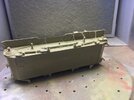Jakko,
Not only did we not attack LM, we had our ignorance and lack of skill thrown back at us. We are poisoning ourselves and Planet Earth due to our heavy handed sledge hammer approach to our hobby. All would be rectified if we simply developed our skills to the point where coating selection didn't matter. Kindergarten finger paints, craft paint, latex house paint, whatever. It's just a matter of devoting oneself to mastery.
I'm quickly remembering why I join a lot of forums and rarely post anything. Uggg
Not only did we not attack LM, we had our ignorance and lack of skill thrown back at us. We are poisoning ourselves and Planet Earth due to our heavy handed sledge hammer approach to our hobby. All would be rectified if we simply developed our skills to the point where coating selection didn't matter. Kindergarten finger paints, craft paint, latex house paint, whatever. It's just a matter of devoting oneself to mastery.
I'm quickly remembering why I join a lot of forums and rarely post anything. Uggg





